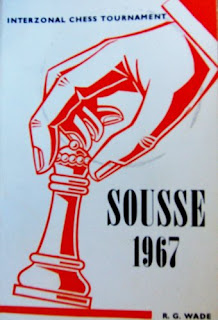White to play
Larsen - Reshevsky, Sousse Interzonal 1967
Some places have stopped being just places to me. That is to say, there are towns and cities with names that are no longer just names. They come with numbers attached.
Say "Reykjavik" to me - like most if not all readers of this blog, I suspect - and it rings the Pavlovian bell marked "1972". The same is true of many World Championship matches (Baguio 1978; Buenos Aires 1927), Olympiads (Lugano 1968; Thessaloniki 1988), Candidates' Matches (Denver 1971; Belgrade 1977/78) and tournaments (Hastings 1895, New York 1924), those quoted being but a handful of dozens which spring to mind. Some are famous (Zurich 1953), some I don't have the faintest clue what went on (Ostend 1907), but I know that something did.
Places aren’t just places for me any more. They’re locations of chess events.
13 a3
Fischer - Myagmarsuren, Sousse Interzonal 1967
Sousse is a bit different. It comes with a number and another word: Interzonal. I can’t hear or read "Sousse" any more without mentally adding "Interzonal 1967" at the end.
Fischer dropping out, going back and then quitting for good - but playing that game in the King’s Indian Attack against Myagmarsuren before he legged. The tournament may have taken place a year before I was born, but these are the things that come to mind when I hear or read of Sousse. Not that I did hear about the town very often before Friday.
White to play
It seems there was only one king and pawn ending at the Sousse Interzonal. It lasted precisely one and a half moves.
It's not tremendously difficult to evaluate the consequences of trading down. Not even for an average club chesser. I assume, therefore, that the pawn ending only happened at all because Reshevsky was in zeitnot as usual and that it was only on reaching the control after
59 Bxc4 bxc4, 60 Kxc4 Kc6, 61 Kd4
that he found he had time enough to resign.
Sousse? No.
Sousse Interzonal 1967. That’s how it’s been and - some twat with a rifle or otherwise - that’s how it’s going to stay.
King and pawn Index
With thanks to Angus




1 comment:
Not sure about the time pressure angle. In those days the time control would have been 40 in 2.5, adjournment, followed by two controls of 17 in 1 before the second adjournment. Or something like that. Reshevsky was a well-known bitter-ender, that's the simpler and more likely explanation.
Post a Comment